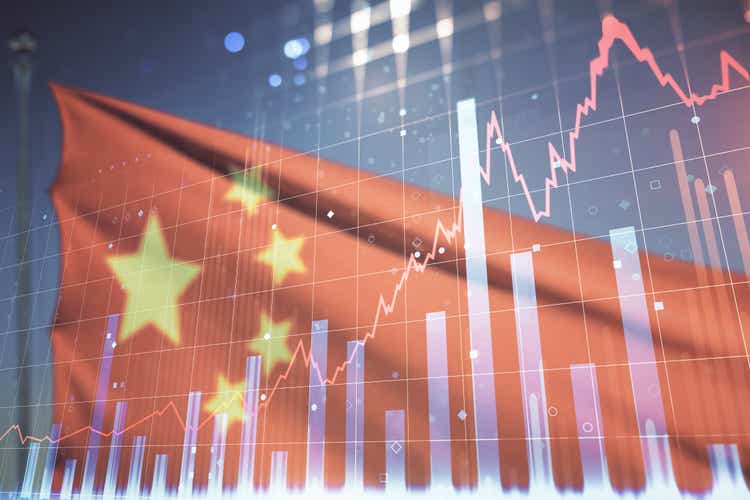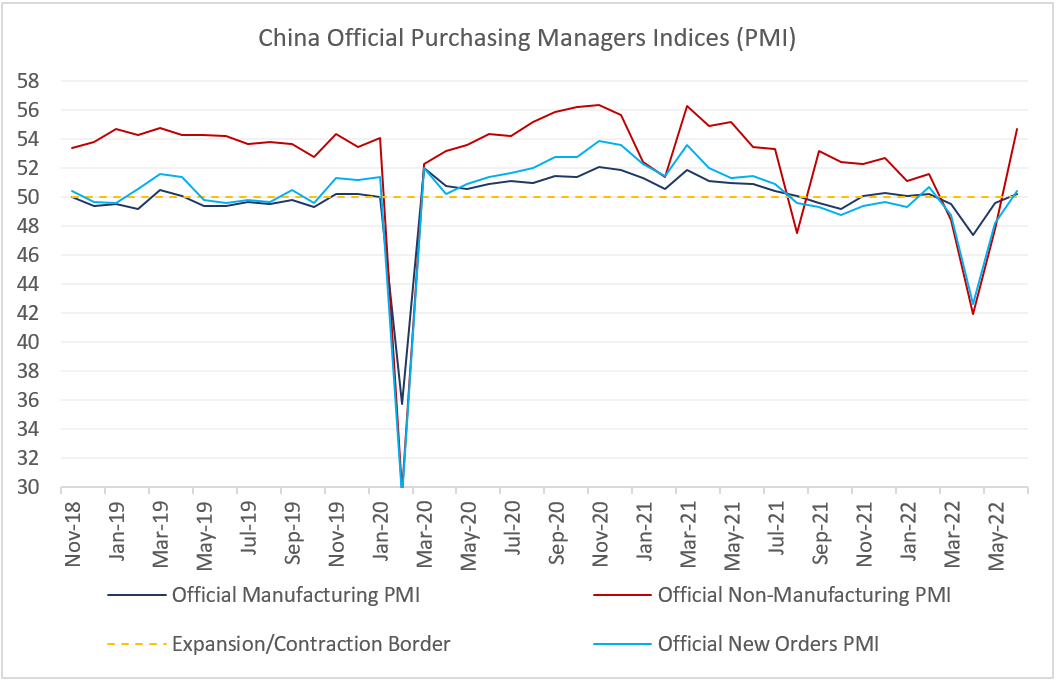Igor Kutyaev/iStock via Getty Images
China’s activity gauges improved further in June, but persistent growth headwinds – which now include a growing global recession risk – might require further policy support, especially on the demand side.
China Growth Rebound
China’s domestic activity gauges continued to rebound from April’s low, lifting China’s equities on a risk-off day. Both the manufacturing and services PMIs (official Purchasing Managers Indices) moved to expansion territory in June (see chart below), with a big jump in the non-manufacturing survey (from 47.8 to 54.7 – well above the consensus) looking particularly impressive. The improvement was broad-based, but details show that closing the gap between the growth forecast (cut to 4.1%) and this year’s official target of about 5.5% will not be easy and might require additional policy support. And the zero-COVID policy will continue to pose a risk to the growth outlook for months to come – the recent easing of some restrictions notwithstanding.
China Infrastructure-Led Growth
The coast is not clear. The PMI for small companies remained in the contraction zone in June, lagging behind state-owned enterprises and medium enterprises. The labor market is still under pressure (employment PMIs are also deep in the contraction zone). And even in manufacturing, demand-side indices were not doing particularly well (new orders PMI barely above 50.0, new export orders PMI still in contraction zone). China’s latest stimulus package is mostly supply-side oriented, which suggests that near-term growth will be led by investments/infrastructure. This is not bad, per se – the market would be happy to see the improving activity dataflow – but moving away from the consumption-led growth model could be regressive from the structural point of view, and this can create a new set of problems in the future.
China Growth and Global Recession
The final concern is that China’s rebound should be considered against the backdrop of growing global recession risk. China’s past experience showed that it can buck the negative global growth trend, but this once again brings us back to demand-side policy support because China’s exports might be hit by weaker growth in its main trading partners. We hope to get more color on these issues from the next batch of China’s credit aggregates (out in the next week or so). Stay tuned!
Chart at a Glance: China Activity Gauges Back in Expansion Zone
Bloomberg LP
PMI – Purchasing Managers’ Index: economic indicators derived from monthly surveys of private sector companies. A reading above 50 indicates expansion, and a reading below 50 indicates contraction; ISM – Institute for Supply Management PMI: ISM releases an index based on more than 400 purchasing and supply managers surveys; both in the manufacturing and non-manufacturing industries; CPI – Consumer Price Index: an index of the variation in prices paid by typical consumers for retail goods and other items; PPI – Producer Price Index: a family of indexes that measures the average change in selling prices received by domestic producers of goods and services over time; PCE inflation – Personal Consumption Expenditures Price Index: one measure of U.S. inflation, tracking the change in prices of goods and services purchased by consumers throughout the economy; MSCI – Morgan Stanley Capital International: an American provider of equity, fixed income, hedge fund stock market indexes, and equity portfolio analysis tools; VIX – CBOE Volatility Index: an index created by the Chicago Board Options Exchange (CBOE), which shows the market’s expectation of 30-day volatility. It is constructed using the implied volatilities on S&P 500 index options.; GBI-EM – JP Morgan’s Government Bond Index – Emerging Markets: comprehensive emerging market debt benchmarks that track local currency bonds issued by Emerging market governments; EMBI – JP Morgan’s Emerging Market Bond Index: JP Morgan’s index of dollar-denominated sovereign bonds issued by a selection of emerging market countries; EMBIG – JP Morgan’s Emerging Market Bond Index Global: tracks total returns for traded external debt instruments in emerging markets.
The information presented does not involve the rendering of personalized investment, financial, legal, or tax advice. This is not an offer to buy or sell, or a solicitation of any offer to buy or sell any of the securities mentioned herein. Certain statements contained herein may constitute projections, forecasts, and other forward-looking statements, which do not reflect actual results. Certain information may be provided by third-party sources and, although believed to be reliable, it has not been independently verified and its accuracy or completeness cannot be guaranteed. Any opinions, projections, forecasts, and forward-looking statements presented herein are valid as the date of this communication and are subject to change. The information herein represents the opinion of the author(S), but not necessarily those of VanEck.
Investing in international markets carries risks such as currency fluctuation, regulatory risks, economic and political instability. Emerging markets involve heightened risks related to the same factors as well as increased volatility, lower trading volume, and less liquidity. Emerging markets can have greater custodial and operational risks, and less developed legal and accounting systems than developed markets.
All investing is subject to risk, including the possible loss of the money you invest. As with any investment strategy, there is no guarantee that investment objectives will be met and investors may lose money. Diversification does not ensure a profit or protect against a loss in a declining market. Past performance is no guarantee of future performance.
Editor’s Note: The summary bullets for this article were chosen by Seeking Alpha editors.


Be the first to comment